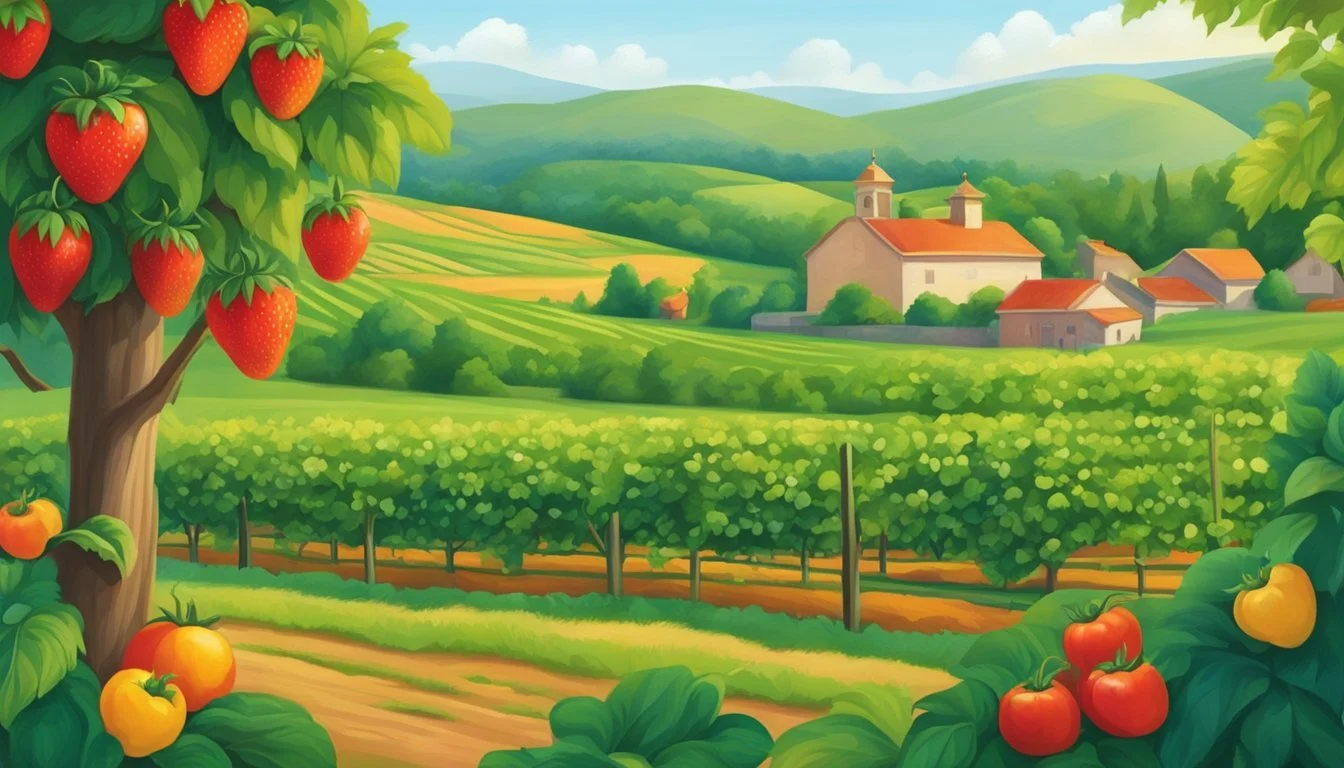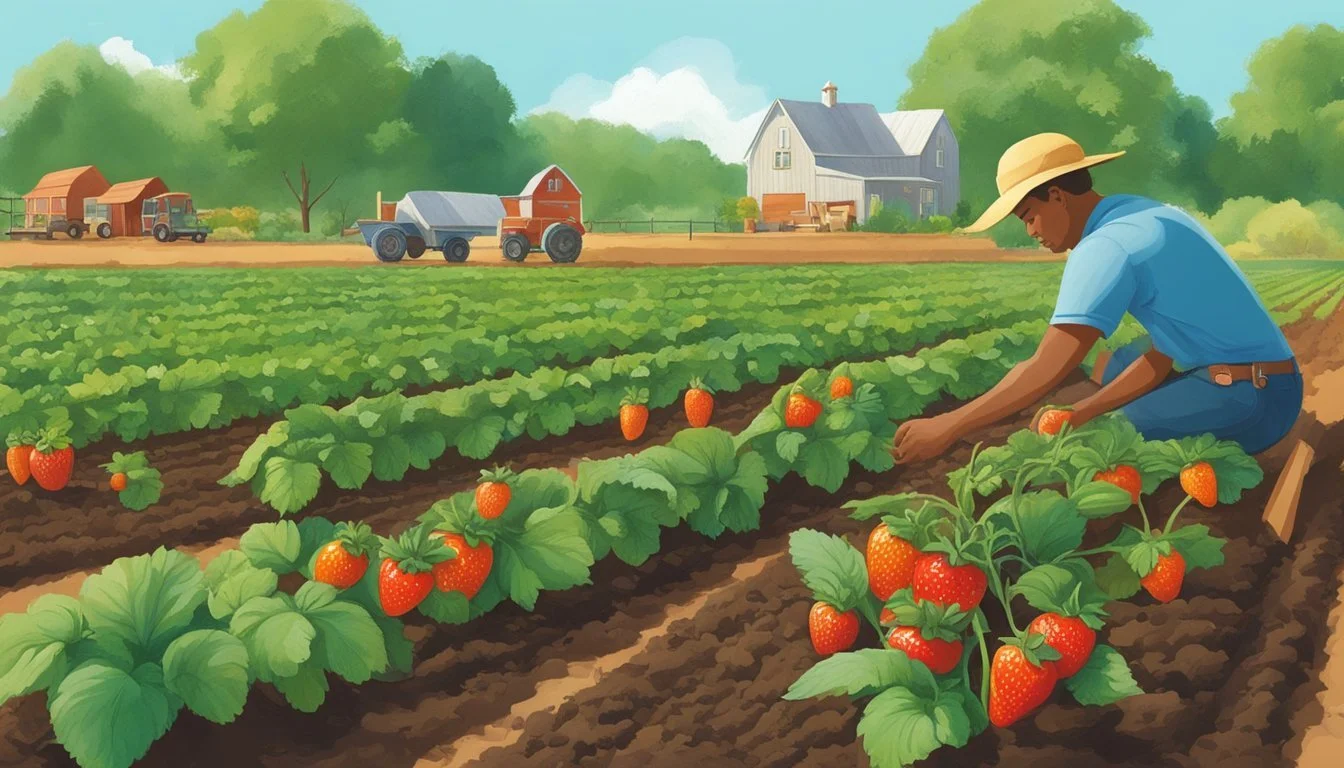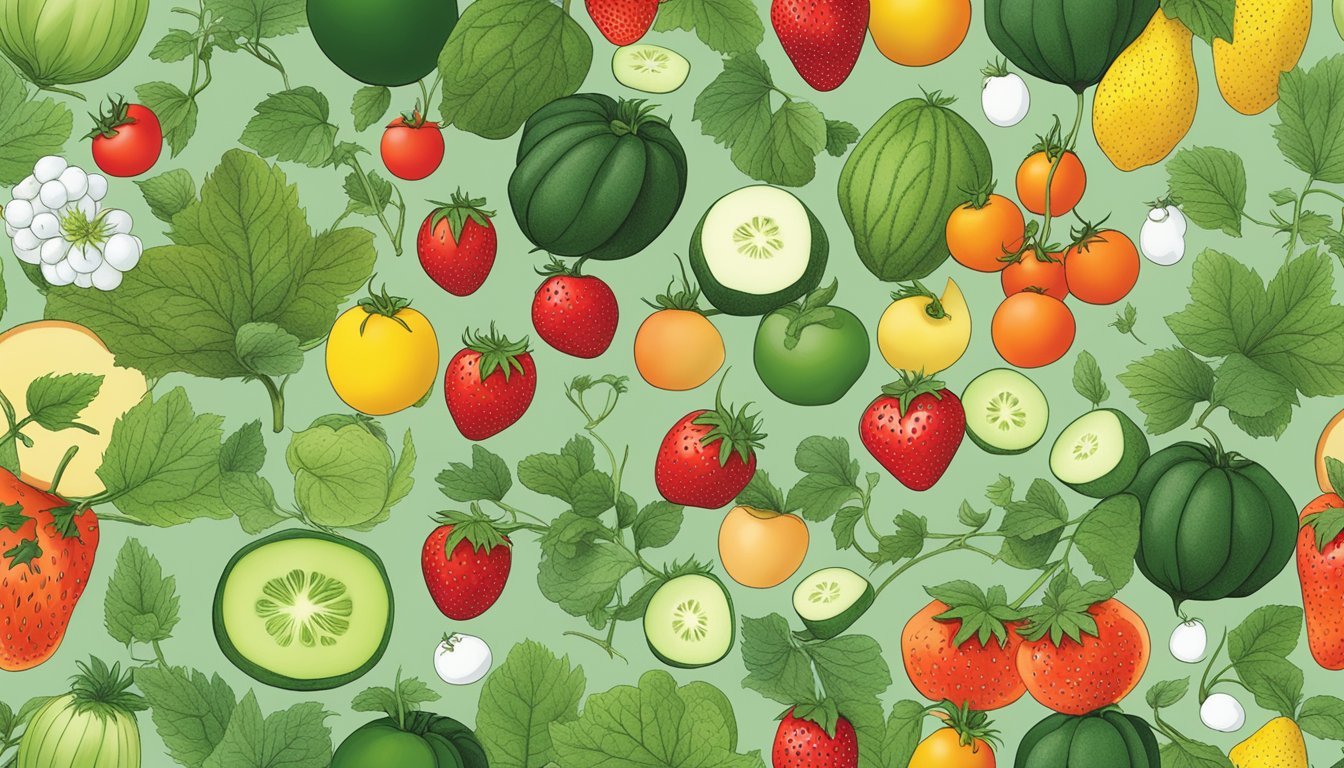Arkansas Seasonal Fruit & Vegetables in May
Your Fresh Guide
This Article is Part of our Arkansas Seasonal Fruit & Veg Calendar
As the calendar turns to May, Arkansas celebrates a bountiful season of fresh produce. The state's temperate climate and fertile soil foster a diverse array of fruits and vegetables that come into their prime this month. Consumers looking for the freshest local flavors will find May to be a rewarding time, with markets and farm stands beginning to offer a colorful selection of produce that embodies the taste of spring transitioning into summer.
Among the fruits that ripen in May are strawberries, a favorite that is often one of the first to herald the start of the fruit season in Arkansas. These juicy, red berries become widely available and are a staple at local farmers' markets. On the vegetable front, leafy greens such as spinach (What wine goes well with spinach?) and a variety of lettuces reach optimal freshness, providing the base for nutritious and vibrant salads. Arkansas's agricultural scene in May is also marked by the emergence of new potatoes, radishes, and green onions, which add crunch and flavor to the season's dishes.
Buying locally-grown produce not only supports Arkansas's farmers but also ensures that consumers enjoy the most flavorful and nutrient-rich produce. Seasonal eating aligns with the natural growing cycles, and May's offerings in Arkansas present an excellent opportunity for locals and visitors alike to indulge in the freshness that abounds within the state's borders.
Overview of Arkansas Seasonality
Arkansas's diverse climate, encompassing USDA hardiness zones 6 through 8, supports a wide range of fruits and vegetables throughout the year. The state's agricultural output shifts with the seasons, from the vibrant greens of spring to the rich hues of fall harvests.
Spring in Arkansas ushers in a period of renewal as numerous crops begin to flourish. By May, the state's agriculture is in full swing. They can expect an abundance of fresh produce as the temperatures warm, and the days grow longer.
Arkansas's vegetable offerings during spring include crisp favorites such as:
Asparagus
Broccoli (how long does broccoli last?)
Cabbage
Carrots
Leafy greens like lettuce and spinach
These vegetables are typically at their peak in spring, delivering fresh, nutritious options to local markets.
As for fruits, Arkansas sees a variety in season. Strawberries ripen first, usually ready by May, closely followed by cherries and blueberries as summer approaches. These fruits not only add sweetness and variety to the diet but also mark the beginning of the fruit harvest season, leading up to the bounties of summer.
The transition from spring to summer sees a shift from cooler-weather crops to those that thrive in warmth, such as tomatoes, peppers, and sweet corn. Arkansas's seasonal produce reflects a balance between temperate and warmer climate crops, emphasizing local and fresh produce from backyard gardens to farmer's markets.
Monthly Harvest Guide for May
In May, the state of Arkansas bursts with a variety of fresh fruits and vegetables ripe for the picking. The warming temperatures and rain of late spring contribute to the growth and maturation of several crops. Arkansas farmers and home gardeners are busy during this month, as it marks a significant time for harvests.
Vegetables: The month of May is an excellent time for a variety of leafy greens which thrive in the mild spring temperatures. These include:
Lettuce: A staple in salads.
Spinach: Rich in iron and versatile in dishes.
Kale: Offers a hearty, nutritional boost.
Root vegetables like radishes and carrots also reach maturity and can be harvested. Additionally, broccoli and cucumbers begin to come into season.
Fruits: While May isn’t peak fruit season in Arkansas, there are still some early arrivals in the fruit category. Strawberries, for instance:
Strawberries: These typically arrive in late April or early May and can continue to be picked throughout the month.
Here is a quick reference table for Arkansas's May harvest:
Fruits Vegetables Strawberries Lettuce Spinach Radishes Carrots Broccoli Cucumbers Kale
As May progresses, gardeners and farmers keep an eye on the weather to ensure that these crops are not affected by late spring frosts, which can occasionally occur. Consumers seeking fresh, locally-grown produce can find these selections at Arkansas's farmers markets, local grocers, or by participating in community-supported agriculture (CSA) programs.
Key Fruits in Season
As May arrives in Arkansas, an abundance of ripening fruits graces the local markets. This section delves into the specific fruits you can expect to find, categorized to enhance your understanding.
Berries
Strawberries make their sweet, vibrant appearance, offering a rich source of vitamin C and antioxidants.
Availability: Peak Season
Blueberries start to come into season towards the end of May, hinting at the leisurely summer days ahead.
Coming Up: Approaching Season
Blackberries are on the cusp of their season, preparing to deliver their juicy, tart flavors soon.
Up Next: Late May - Early June
Stone Fruits
Peaches and nectarines are still a whisper away from their summer debut in Arkansas.
Anticipated: June through August
Melons
Cantaloupe (how long does cantaloupe last?)and watermelon are not quite at their peak, but the warm weather in May paves the way for their upcoming harvest.
Expected: Late May - Early Summer
Arkansas offers these fruits as they begin to reach maturity, allowing for the freshest and most flavorful experience when purchased in season.
Key Vegetables in Season
May in Arkansas heralds a time of abundance for various vegetables. Gardeners and consumers alike can look forward to fresh produce that offers a medley of flavors and nutrients.
Leafy Greens
Lettuce and kale are thriving during May. Lettuce, with its crisp texture, is great for salads, while the sturdy leaves of kale hold up well in cooking, becoming a versatile ingredient for a range of dishes.
Root Vegetables
Beets and radishes are in their prime. The earthy sweetness of beets contrasts well with the peppery bite of radishes, offering variety to the palate.
Nightshades
May is not peak season for Arkansas-grown nightshade vegetables such as tomatoes, peppers, and eggplant. These typically begin to appear later in the season as the weather warms up.
Legumes
The legume family is represented with both beans and peas, which start to become available in May. Whether one prefers the snap of a green bean or the sweetness of fresh peas, both are excellent choices for springtime meals.
Planning and Planting
May is a pivotal month for garden enthusiasts in Arkansas. With the last frost behind them, gardeners can confidently transition to planting a variety of seasonal fruits and vegetables. Utilizing the Arkansas vegetable planting calendar, gardeners can create a planting schedule tailored to the region's climate, ensuring a successful harvest.
Vegetables to Plant
In May, the focus shifts to warm-season crops that thrive in Arkansas’s late spring temperatures:
Beans: Both bush and pole varieties can be sown directly into the garden.
Sweet Corn: Plant in well-drained soil in full sun for best yields.
Potatoes: May is the last window for planting to ensure a summer harvest.
Okra: Sow these heat-loving seeds directly into the garden.
Fruit and Other Crops:
Biennials: Carrots and beets seeded now will be ready for later seasons.
Perennials: Establish plants like daisies and daylilies, which can add diversity and attract pollinators to the garden.
Transplants versus direct seeding should be considered based on the crop. It’s often beneficial to start with transplants for crops like tomatoes and peppers, as they require a longer growing season than Arkansas may provide from seed to fruit.
Garden Layout
When planning the garden layout:
Ensure adequate space for the mature size of plants.
Incorporate paths for easy access to tend crops.
Group plants with similar water and sun requirements.
Following these informed practices helps Arkansas gardeners achieve a bountiful and enjoyable growing season.
Cultivation Techniques
The success of fruit and vegetable crops in Arkansas during May depends on effective soil preparation and ongoing care such as pruning and maintenance. These steps are essential to mitigate the impacts of variable weather and potential problems from pests, diseases, and extreme temperatures.
Soil Preparation
Proper soil preparation lays the foundation for the healthy growth of seasonal crops. A gardener should:
Test the soil to determine pH level and nutrient composition.
Amend the soil with the necessary nutrients or pH adjusters, aiming for a pH between 5.5 and 7.5, ideal for most fruits and vegetables.
Ensure good drainage to prevent root rot and other water-related issues.
Aerate the soil to facilitate the root growth and water absorption.
Pruning and Maintenance
Regular care is crucial to manage plant health and optimize yield:
Prune fruit trees to remove dead or diseased wood and to shape the canopy, which allows for better air circulation and sunlight penetration.
Carefully monitor for pests such as aphids and for diseases like powdery mildew, especially as temperatures rise.
Thin out crops like fruit trees to prevent branches from breaking under weight and to ensure the remaining fruits grow larger.
Apply mulch to conserve moisture, regulate soil temperature, and reduce weed competition.
Maximizing Flavor and Nutrition
Purchasing fruits and vegetables during their peak season ensures maximum flavor and optimal nutrition. For Arkansas residents, May is a notable month for enjoying a variety of produce that is both vibrant in taste and packed with nutrients.
Fruits that are particularly succulent and ripe during this time include strawberries and blueberries. They not only offer a burst of natural sweetness but are also rich in vitamins and antioxidants. These berries can be incorporated into a diet to contribute to overall health and wellness.
Vegetables such as spinach and broccoli make their seasonal appearance and are important to include in meals due to their high vitamin and mineral content. These leafy greens are versatile and can be effortlessly added to dishes to enhance nutritional value.
Seasonal Produce Flavor Profile Nutritional Highlight Strawberries Sweet and tangy High in Vitamin C and manganese Blueberries Juicy and sweet Rich in antioxidants and Vitamin K Spinach Earthy and mild Loaded with iron and calcium Broccoli Slightly bitter, earthy Vitamin C and K, and fiber-rich
Consumers are encouraged to support local Arkansas markets. By doing so, they benefit from the freshest produce, which is less likely to lose nutritional value from prolonged transportation or storage. This practice not only delivers superior taste and health advantages but also bolsters local economies. Prioritizing the consumption of seasonal fruits and vegetables is a confident step towards a flavorful diet and a healthier lifestyle.
Local Food Movements in Arkansas
In Arkansas, the local food movement has gained momentum, emphasizing the consumption of fresh, locally-sourced produce. Major cities like Little Rock, Fayetteville, Fort Smith, and Jonesboro host farmers' markets where residents can access the freshest fruits and vegetables. These markets also serve as community hubs, fostering direct relationships between farmers and consumers.
The Ozark region, known for its rich agricultural history, and Pine Bluff play significant roles in the state's push for local food initiatives. Texarkana, straddling the border with Texas, offers a unique blend of cross-state local products.
City Notable Local Produce Markets Little Rock Little Rock Farmers' Market Fayetteville Fayetteville Farmers' Market Fort Smith Fort Smith Farmers' Market Jonesboro ASU Regional Farmers' Market Ozark Ozark Farmers' Market Pine Bluff Southeast Arkansas Farmers' Market Texarkana Gateway Farmers' Market
Community-supported agriculture (CSA) programs are also prevalent throughout the state, where individuals can subscribe to receive regular deliveries of seasonal produce, thus ensuring they get the freshest offerings while supporting local growers.
In addition to farmers' markets and CSAs, food co-operatives in these cities endorse the local food ideology. These co-ops often source products directly from Arkansas farmers, thereby guaranteeing freshness and seasonal variety. The local food movement in Arkansas stands as a testament to the state's commitment to sustainable agriculture and community well-being.
Hardiness and Climate Zones
When planning a garden in Arkansas during May, understanding hardiness zones is crucial. These zones guide gardeners on what fruit and vegetables can be planted based on the location's climate, specifically the area's average annual extreme minimum temperature.
Arkansas is encompassed by three primary USDA hardiness zones:
Zone 6: This zone experiences colder winters, making it ideal for plants that can endure cooler temperatures.
Zone 7: Known as a moderate zone, it allows for a wide range of plants, including several cold-hardy fruits and vegetables.
Zone 8: This zone typically has milder winters, favoring plants that need warmer conditions to thrive.
Here is a breakdown of the state's zoning:
Zone Average Low Temperature (°F) 6 -10 to 0 7 0 to 10 8 10 to 20
The weather in each zone affects the growing season. For example, Zone 6 might have a shorter window for frost-sensitive plants compared to Zone 8, where the growing season begins earlier and ends later.
The hardiness map provides a visual representation of these zones, helping gardeners in Arkansas decide when to sow various crops. Considering this information can be especially significant in May, which often marks the transition from spring to summer crops in the state's gardening calendar.
Gardening Challenges
In Arkansas, the month of May can present a set of unique challenges for gardeners. Specific weather patterns and the prevalence of pests and diseases can significantly affect the success of a vegetable garden.
Weather Considerations
May in Arkansas often brings a transition from cool to warm temperatures, which can sometimes include unpredictable cold spells. Gardeners must be vigilant and ready to protect their plants, especially warm-season vegetables, from any late frosts that could damage or kill them.
Temperature shifts: Sudden drops in temperature can stunt plant growth.
Rainfall: While adequate moisture is crucial, excessive rain can lead to root rot and other water-related issues.
To mitigate these risks, they should:
Monitor forecasts: Keep an eye on local weather predictions.
Implement protection: Use row covers or cold frames to shield sensitive plants during a cold spell.
Pests and Diseases
Pests and diseases can wreak havoc in a May garden. The appearance of insects and the spread of disease are significant concerns that can quickly escalate if not addressed promptly and effectively.
Insects: Aphids, spider mites, and cutworms are common and can damage a range of vegetables.
Disease: Fungal diseases like powdery mildew can thrive in warm, humid conditions that are typical in Arkansas this time of year.
Gardeners should adopt integrated pest management strategies:
Regular inspections: Check plants frequently for signs of pests or disease.
Prompt treatment: Apply appropriate organic or chemical treatments as needed to control the infestation and prevent the spread of diseases.
By understanding and anticipating these challenges, gardeners in Arkansas can take proactive measures to ensure a thriving garden in the month of May.
Harvest and Storage Tips
In Arkansas, May is a bountiful month for harvesting a variety of fruits and vegetables. Proper harvest and storage are key to extending the shelf life of this fresh produce. Berries, for instance, should be picked early in the morning and refrigerated immediately. They can also be frozen on a baking sheet before being transferred to freezer bags for long-term storage.
Leafy greens, including kale and spinach, thrive in May's weather. They should be harvested while the leaves are still tender and stored in the refrigerator's crisper drawer to maintain freshness. Collards, with their robust leaves, are more resilient and can last longer when kept cool and moist.
Vegetables:
Root vegetables: Turnips and radishes can be dug up this month. After harvesting, one should remove the tops to prevent moisture loss, then store in a cool, dark place or refrigerate.
Nightshades: Tomatoes and peppers, should be picked when ripe and stored at room temperature for a few days; refrigeration can diminish their flavor unless they're fully ripe.
Preservation Methods:
Canning: Suitable for tomatoes, it preserves their flavor and extends shelf life.
Freezing: Effective for greens—blanching before freezing retains color and nutrients.
To maximize longevity, canning and freezing methods should be undertaken with cleanliness and care to avoid contamination. Always check for guidelines specific to each fruit and vegetable for best results.
Arkansas Extension Resources
The University of Arkansas System Division of Agriculture offers a wealth of educational resources for those interested in seasonal fruits and vegetables. These resources provide valuable information on planting, harvesting, and managing produce through its Cooperative Extension Service.
Gardeners seeking guidance can refer to publication FSA6001, which delivers detailed planting dates, tailored to Arkansas’s different climate zones. For those focused on fruit, vegetable, and nut production, the Arkansas Fruit, Vegetable, and Nut Update blog serves as a crucial touchpoint, featuring expert insights and timely updates.
Available resources include:
Planting Guides:
Comprehensive charts
Optimal planting schedules
Cultivation Tips:
Sunlight and shade requirements
Soil preparation techniques
Expert Contact Information:
Direct lines for specialist assistance
Email addresses for in-depth inquiries
To further support agricultural endeavors, the Extension offers workshops and events tailored to Arkansas's diversity in produce. They emphasize sustainable practices and integrated pest management to ensure a healthy yield.
Leveraging these resources in May, when Arkansas’s growing season picks up pace, enables growers to make informed decisions, ensuring a bountiful harvest of fruits like strawberries and vegetables such as tomatoes and cucumbers.














